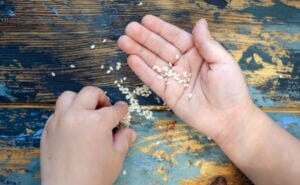
Oral immunotherapy (OIT) for sesame allergy is safe and effective, with 71 percent of kids reaching a maintenance dose and 19 percent progressing toward it several months into dosing, a new study finds.
Researchers at Mount Sinai Hospital in New York reviewed the charts of 86 sesame-allergic kids. The children, whose average age was 3 years old, received oral immunotherapy starting with crushed sesame seeds and moving onto tahini, a concentrated sesame paste.
Before starting sesame OIT, the children underwent an oral food challenge to as much as 21 crushed sesame seeds. If they passed, they were sent home to start a daily dose of about 6 mg of sesame protein (12 crushed sesame seeds).
The kids then gradually increased the amount they could consume over the course of several months. Sixty-one children reached the maintenance dose of one teaspoon of tahini, or about 1,000 milligrams (mg) of sesame protein.
Another 16 children were still in the buildup phase of dosing at the time of the study’s completion. Nine kids dropped out of the study because of reactions, uncontrolled asthma, or difficulty with daily dosing.
After an average of one year of eating a maintenance dose of 1,000 mg of sesame daily, children underwent skin and blood testing. If those results looked good, the kids could do a food challenge of up to one tablespoon of tahini, or 3,000 mg of sesame protein.
Researchers offered 14 children the chance to do the 3,000 mg challenge. All 14 passed.
“That was three times the sesame protein amount of their daily dose, and this was considered the desensitization challenge,” says Dr. Ami Shah, a Mount Sinai allergy and immunology fellow who led the research.
Sesame OIT and Remission
Those kids were then asked to stopped eating sesame for four to six weeks, and then did the same food challenge. None of the children reacted.
“Our data suggests that there is a significant number of pediatric sesame-allergic patients who could achieve remission, or at least have their diet liberalized, in a safe and effective way,” Shah says.
Sesame is in a wide variety of foods, including hummus, bread, crackers and sushi. “With the increase in prevalence of sesame in our diets, we have also seen an increase in the prevalence of sesame allergy,” Shah says.
It’s estimated that 1 to 1.5 million Americans have a sesame allergy, and 38 percent have experienced a severe allergic reaction due to sesame. Kids don’t typically outgrow sesame allergy.
During treatment, about 30 percent experienced allergic reactions, mostly during the up-dosing phase. Reactions were mostly mild and included localized hives or skin redness, although a few experienced lip swelling, tongue itching or stomach pain.
Stomach pain led a few kids to drop out, and a few to slow down their up-dosing schedule. One patient developed eosinophilic esophagitis (EoE) while on sesame maintenance. Only one study participant had respiratory symptoms and required epinephrine to treat a reaction.
“The safety data we collected was encouraging,” Shah says of the research presented at the 2023 Annual Meeting of the American Academy of Allergy, Asthma & Immunology (AAAAI).
Previous studies by researchers in Israel have found sesame OIT very effective in desensitizing children. But there has been little research among U.S. kids, Shah notes.
Related Reading: Bread Suppliers ‘Adding Sesame’ as Seed Becomes Top Allergen
AAAAI: In Oral Food Challenge, Skin Water Loss Can Predict Anaphylaxis Risk
AAAAI: Very Low-Dose Peanut OIT Helps to Desensitize
Recipes: Sesame-Free Grilled Eggplant Dip





